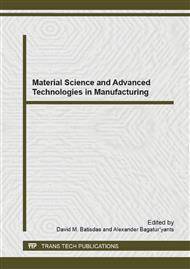p.121
p.127
p.132
p.137
p.142
p.147
p.153
p.157
p.163
Theoretical Analysis on Resistance-Temperature Characteristic of Ni/HCl-PANI Composites
Abstract:
Ni/HCl-PANI composites were formed by depositing Ni films on HCl-doped polyaniline (HCl-PANI) substrates. A simple parallel resistor model is used to analyze the resistance-temperature (R-T) characteristic of the composite within 30-300 K. The theoretical analysis reveals that the composite exhibits a metal-semiconductor transition within a certain thickness of the Ni film or the HCl-PANI substrate. The composite shows a semiconducting behavior at temperatures over the transition temperature and a metallic conduction behavior at temperatures below the transition temperature. The transition temperature increases with increasing Ni film thickness whereas it decreases with increasing HCl-PANI substrate thickness. When the Ni film thickness exceeds its upper limit or the HCl-PANI substrate thickness is below its lower limit, the composite only shows the metallic R-T characteristic. When the HCl-PANI substrate thickness exceeds its upper limit, the composite only exhibits the semicoducting R-T characteristic.
Info:
Periodical:
Pages:
142-146
Citation:
Online since:
January 2014
Authors:
Price:
Сopyright:
© 2014 Trans Tech Publications Ltd. All Rights Reserved
Share:
Citation:


